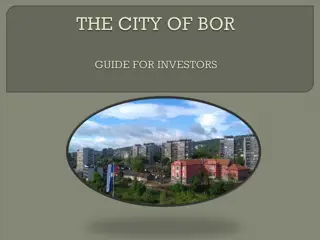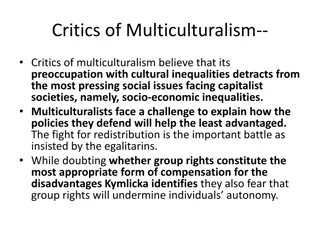The Geographical History of Shish Kebab: Tracing Its Cultural Landscape
Exploring the geographical concepts of region, diffusion, and cultural landscapes through the history of Turkish Shish Kebab. The presentation delves into the roots of the term, its significance in Turkish nomadic tribes, and diffusion across regions like the Middle East, Asia, and Europe.
Uploaded on Sep 16, 2024 | 0 Views
Download Presentation

Please find below an Image/Link to download the presentation.
The content on the website is provided AS IS for your information and personal use only. It may not be sold, licensed, or shared on other websites without obtaining consent from the author. Download presentation by click this link. If you encounter any issues during the download, it is possible that the publisher has removed the file from their server.
E N D
Presentation Transcript
The Geographical History of Shish Kebab Student Name Course Name and Number Professor Date
Purpose Introduction Region Diffusion Defined Diffusion of the Shish Kebab Cultural Landscape Defined Cultural Landscape of the Shish Kebab Distance Decay Defined Distance Decay of Shish Kebab Conclusion References Table of Contents
The purpose of this presentation is to demonstrate how geographical concepts of region, diffusion, cultural landscapes, and distance decay can be understood by tracing the history of the Turkish Shish Kebab. The Shish Kebab was selected as the subject of this demonstration for its relevance and familiarity to me and my family background. Purpose
The term shish kebab is based on the Turkish words for skewer and roasted meat. Nomadic tribes in ancient Turkey found the shish kebab to be a convenient way of preparing meat that had been stored and dried. Marinating the dried meats in oil and spices prepared them for heating over fire, making the meat tender and flavorful. Introduction
Turkey is at the northeast end of the Mediterranean Sea, situated between Southeast Europe and Southwest Asia Turkey historically served as a route connecting many parts of the ancient world, and customs and cultural traditions from the region have been carried around the globe The traditional kebab was a staple of nomadic Turks and is now found throughout the world Region
Map Region
Diffusion The spatial spreading or dissemination of a culture element (such as a technological innovation) or some other phenomenon ( e.g., a disease outbreak). For the various channels of outward geographic spread from a source area, see contagious, expansion, hierarchical, and relocation diffusion. Cultural Diffusion Defined
The Shish Kebab was carried throughout the Middle East, Asia, and Europe. Arabian cultures have a similar food, spelled shish kabab, and the traditional preparations of spiced meats roasted on skewers is found as far away as Japan and China to the East and the United States to the West. An alternative version of the shish kebab, the Doner Kebab, uses ground lamb and other meats roasted on a vertical skewer. This meat is served on pita bread, and this method is also known in Greece and other regions as the gyro Diffusion of the Shish Kebab
Cultural Landscape The forms and artifacts placed on the natural landscape by the activities of various human occupants. By this progressive imprinting of the human presence, the physical (natural) landscape is modified into the cultural landscape, forming an interaction unity between the two. Cultural Landscape Defined
Restaurants throughout the U.S. and the world serve shish kebabs and other traditional Turkish foods. The Doner Kebab is a popular fast food item around the world, and is offered with regional variations in preparation and presentation. The Greek version, the gyro, is a popular item in restaurants in the U.S. Cultural Landscape
Distance Decay - The various degenerative effects of distance on human spatial structures and interactions. Distance Decay Defined
Although Shish Kebab and other Turkish foods are found around the world, they have not been assimilated into other cultures in the same way that some foods have. Kebabs are still strongly associated with their regional backgrounds, and in the U.S. they are most often served in restaurants that offer Turkish, Middle Eastern or Greek dishes. Distance Decay
Shish Kebabs have become a popular food around the world. They have maintained most aspects of their original form, though regional variations can be found in different countries. Turkish restaurants around the world serve traditional shish kebabs along with other traditional offerings, and the influence of this Turkish staple is seen in foods ranging from Greece to East Asia to the United States. Conclusion
Cliffordawright.com. 2014. Did You Know: Food History - On Shish Kebabs. [online] Available at: http://www.cliffordawright.com/caw/food/entries/display.php/topic_id/7/id/7/ [Accessed: 30 Jan 2014]. Encrypted-tbn1.gstatic.com. 2014. Map of Ancient Turkey. [online] Available at: https://encrypted- tbn1.gstatic.com/images?q=tbn:ANd9GcSyQYoYm1MOQhvkPn7YhL5rVGUzlU56 S__zPzr-8zaHMi0Y8bDi6g [Accessed: 30 Jan 2014]. Encrypted-tbn2.gstatic.com. 2014. [online] Available at: https://encrypted- tbn2.gstatic.com/images?q=tbn:ANd9GcRRoBx6Vg1IBUlpn9GaGIQJpfyE39PJE4 mBb2UxVjyHVoWDLWEJGA [Accessed: 30 Jan 2014]. Geraniumhomes.com. 2014. [online] Available at: http://www.geraniumhomes.com/blog/wp-content/uploads/2013/06/Shish- Kebab.jpg [Accessed: 30 Jan 2014]. Turkishfoodandrecipes.com. 2014. History of Shish Kebab. [online] Available at: http://www.turkishfoodandrecipes.com/2008/11/history-of-shish- kebab.html [Accessed: 30 Jan 2014]. Yelp.com. 2014. The Kebab Shop. [online] Available at: http://www.yelp.com/biz/the-kebab-shop-san-diego [Accessed: 30 Jan 2014]. References

























